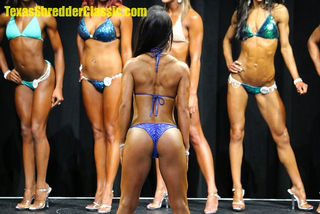Diet
Is There Feminine Muscularity?
Research explains how visibly muscular women feel about their bodies.
Posted March 29, 2017
In Western culture, women’s ideal body shape is very thin and unsurprisingly, many women exercise primarily to lose weight. In this context, muscularity is often associated with masculinity and thus, feared by many women who prefer firm and tight, but not bulky bodies. On the other hand, there are a number of physical activities that openly encourage women to build stronger, visibly muscular bodies. For example, in CrossFit boxes “There is no such thing as ‘firming’ and ‘toning’ there is only stronger and weaker” (cited in Knapp, 2015, p. 48). In a different context, women bodybuilders desire to display fully developed muscular bodies. Many feminist researchers have argued that these muscular women challenge common conceptions about femininity. In an earlier blog (Feminine Physique, November 26, 2014) I discussed the findings from this research.
Women’s bodybuilding is no longer only for women who wish to build an extreme amount of muscle mass. There are several different formats that differ based on the level of desired muscularity. Tajrobehkar (2016) defines bodybuilding in generic terms as sculpting one’s body through rigorous diet and training to gain significant amounts of muscle mass. The exact amount of muscle mass then depends on the type of bodybuilding one desires to participate in. The names for the various categories differ based on the organizing bodybuilding association, but for example in Canada, women can participate in Bikini fitness, Fitness, Figure, Physique, and Bodybuilding categories under the auspices of the Canadian Bodybuilding Federation (CBBF) that is a member of the International Federation of Bodybuilding (IFBB). In this categorization, Bodybuilding requires the most and Bikini the least muscle mass.
In light of these recent developments, can women now build their bodies beyond firmness? What do these muscular women think of their bodies? Has the shape of the ideal feminine body changed? Some researchers have asked women with various levels of visible muscularity about their bodies and about the comments they receive from others around them.

In their study Grogan, Evans, Wright and Hunter (2004) interviewed seven women who had competed in the Physique category in the UK. All the interviewees were white and were 22-43 years old. Like all bodybuilding categories, success in the Physique category is based solely on the body aesthetics: how the body looks rather than its ability to perform a specific task (e.g., Aspridies, O’Halloran, & Liamputtong, 2014).
The Physique category is judged based on femininity, symmetry, muscle tone, poise, and beauty/flow of the physique. The judges look for visible muscle separation and some striation, but not excessive muscularity. The competitors display their physique through performing individual routines (of poses) choreographed to music. Typically, they have 8-10% of body fat.
The researchers described the looks of female Physique competitors as “built up to look large and powerful and strong, and (to the untrained eye) to look similar to the bodies of male body builders” (p. 50). The study participants, obviously, were visibly muscular and thus, their bodies were a definite departure from the toned ideal feminine body. The authors noted, however, that none of the bodybuilders mentioned being large or highly muscled as part of their ideal that they defined as athletic, toned, and healthy. The Physique competitors further emphasized that this athletic shape had to be feminine: a good/nice shape with a visible waist, breasts, and less muscular than a male bodybuilder. Muscles and femininity were not incompatible, the participants insisted, but ‘a muscular woman’ did not ‘get huge’ and retained her feminine shape.
The trained body also increased the women’s self-confidence and their feelings of being sexually attractive. Their feminine body shape, however, was different enough from the ‘normal’ women’s body to attract comments and stares from strangers. The comments from what the bodybuilders called ‘the general public’ were generally positive: Women admired the slender waists and men the powerful looks of the Physique competitors. If there were any negative comments, the bodybuilders ignored them arguing that only opinions of the bodybuilding community mattered and ‘anyone else’ is ‘irrelevant.’
The researchers concluded that, in general, the physique category bodybuilders felt good about their muscular bodies that they tightly controlled through diet and training. While they had to negotiate the mainstream feminine body ideal, they had created their own ideal that was appropriate in the bodybuilding community and was measured against the standards of this community. This ideal, nevertheless, embodied some of the same characteristics (e.g., athletic, not huge, narrow waist, thin) as the feminine looks preferred by the ‘general public.’ The Physique competitors were, however, able to develop an alternative body ideal even if it was limited to the bodybuilding community where they felt accepted and appreciated as feminine muscular women.

Aspridis, O’Halloran, and Liamputtong (2014) interviewed 11 Australian competitors in another women’s bodybuilding category, the Figure class, that requires less muscle definition than the Physique. The Figure category can be described as a blend of bodybuilding and fitness. Instead of an individualized routine of poses, the contestants present quarter turns in front of the judges who assess the competitor’s symmetry, presentation, and aesthetic qualities such as skin tone. The so-called X-shape is important: well developed upper back with well-shaped legs. Similar to the Physique category, visible muscle separation is expected, but as a difference from the Physique category, no muscle striation should be visible. The leanness of the contestant is similar to the Physique category: 8-12% of body fat.
The Figure participants in this study were a similar age range (18-43 years) to the Physique competitors interviewed by Grogan, Evans Wright and Hunter (2004). Like the Physique competitors, the Figure class contestants felt that hard training and strict diet allowed them to gain control of their lives and thus, increased confidence. Physical strength provided feelings of achievement, mental strength, and personal growth that they had not imagined possible before. These women were more confident to take on other pursuits in their lives (going back to school, have a new career) as a result of their changed body shapes. Despite these benefits, the women also reported feeling depressed after a competition, not because of muscle loss, but because of weight gain. Therefore, thinness was an important factor for the Figure class competitors’ ideal body shape.
Unlike the Physique competitors who preferred to focus on positive comments by strangers, the majority of the Figure competitors reported a certain stigma attached to their sport. Some ‘onlookers’ indicated that bodybuilding, particularly its strict dieting practices, was unhealthy and had negative psychological (mood swings) and social impacts (withdrawal from social life). Their comments focused more on excessive thinness than overt amounts of muscle mass. As one participant reported:
“I’ve lost a lot of friends over it because they don’t understand. They say, look at you, you’re skinny, you don’t need a diet, but they do not understand how important the diet is” (p. 27).
The researchers emphasized, nevertheless, that “Although women in this Figure class were not overtly criticized for increased muscularity…the muscular definition exhibited by women in this Figure class was enough for them to be rejected and negatively labelled” (p. 28). The Figure class competitors themselves believed that the positives of competing outweighed any costs of stigmatization or social withdrawal.
If women in the Physique and the Figure categories felt stigmatized because of their body shapes, how do the competitors in the Bikini category, that requires the least amount muscle definition, feel about their bodies?

Instead of the emphasis on the ‘X-shape’ in the Figure category, abdominals and gluteals are important aspects of the lean and firm physique of a Bikini competitor. Proportion, symmetry, balance, shape, and skin tone are judged as they are displayed during front and back poses, walk, and presentation. This category allows the highest level of fat percentage: typically 10-14% of body fat.
Tajrobehkar (2016), a Bikini contestant herself, added that femininity is a mandatory component of Bikini competition. In her study, she interviewed nine Canadian women bodybuilders, six of whom competed in the Bikini category. Similar to the studies cited above, the participants were all white. Unlike the other researchers, Tajrobehkar argued that the Bikini competitions “reproduce and reinforce” traditional femininity, because the contestants are judged based on such femininity criteria as their outfits, shoes, hair, makeup, and facial beauty. In addition, “the competitors with larger breasts are judged more favorably” (p. 295). During their ‘walk’ the contestants are to make ‘suggestive gestures’ and are thus, Tajrobehkar continued, “to display themselves in an overtly sexual manner” (p. 295). Thus, exaggerated heterosexual femininity is the norm in Bikini competitions. We must remember that Tajrobehkar is a Bikini class bodybuilder herself and thus, has first-hand experience of the competitions. What did her fellow Bikini contestants think of the body shape required in these competitions?
The interviewed participants, like the Figure and Physique competitors, felt very positive about muscular women’s bodies. As one participant exclaimed: “I think muscle is great. Muscle in general is fantastic. I think women should have muscle to give them shape” (p. 298).
They immediately explained, though, that muscle needs to add to the femininity of a woman. As another interviewee explained: “You don’t want to come out there not looking all pretty and cute…You have to somehow manage that sexiness, that curvature, that makes a woman beautiful” (p. 298). The Bikini contestants, thus, viewed muscle as positive as long as it added to the sex appeal that was the selling point of the competitions. Indeed, femininity and beauty are openly included as judging components (the bikini walk does not involve any overt demonstration of muscularity) and, the participants acknowledged, the Bikini competitions focus more on feminine beauty than physical fitness. While some of the more muscular interviewees found this category undermining the sport of bodybuilding, others felt that it was “a more fun, sassy approach” (p. 300) to bodybuilding that allowed the women to gain confidence from the display of sexiness in front of an (mostly male) audience. As one participant explained:
“I think that the way you carry yourself on stage, the little twerks you do make you look confident, like you’re comfortable in your own skin. And I think that’s probably a good quality to have” (p. 300).
Based on these findings, women bodybuilders in the Physique, Figure, and Bikini categories felt positive about their newly built body shapes. They all celebrated their muscular, but also very thin bodies. Some were willing to deviate from the societal norms of the acceptable, toned feminine body more than others. It is not surprising that the Physique bodybuilders with visibly ‘separated’ and ‘striated’ muscle mass departed from the ideal the most radically. It must be noted, however, that their muscle mass is not as heavy as in the women’s Bodybuilding category that is also the only category where women pose in bare feet instead of wearing high heel shoes.
The Physique level competitors were also the ones who actively ignored any negative comments from the ‘general public’ to rely on the judgement of their own bodybuilding community. Tajrobehkar (2016) observed that the bodybuilding sub-culture where women were revered for their muscle development provided a safe haven for changing ideas of women’s muscular bodied. This sub-culture, nevertheless, is a much smaller realm than ‘the broader culture’ that continues to exert its own norms of acceptable femininity. The bodybuilding women live in both cultures and thus, continually negotiate their muscular development accordingly.
The bodybuilding culture, influenced by the broader cultural norms, has expanded its list of women’s bodybuilding categories. The Bikini and Figure classes that are the closest to the toned and thin feminine ideal have gained popularity whereas the International Federation of Bodybuilding (IFBB) has cancelled its amateur women’s Bodybuilding category that now exists only as professional competition. One of the participants in Tajrobehkar’s study noted this trend: “All there is now is a male muscle model [one of the male bodybuilding categories with less defined muscle mass] and a Bikini girl. And those are the biggest categories…where is the sport? We lost the sport” (p. 299). This competitor felt that women’s bodybuilding has begun to resemble a beauty contest (with a sexy walk) rather than a sport based on building muscular definition. The IFBB is openly following this trend as it states that high-intensity weight training and hard lean muscles are not necessary for the Bikini category that, instead, requires an attractive appearance similar to models.
Seen in this light, women’s bodybuilding has not managed to change the toned and thin feminine body ideal to any significant degree. On the contrary, the sport has evolved to include categories with less and less muscle definition. Baghurst, Parish, and Denny (2014) add that Physique, Fitness, and Bikini categories are now popular whereas Bodybuilding is in decline. While muscle definition that enhances the looks of the shapely, feminine body is desirable, our culture does not seem quite ready for visibly muscular women’s bodies.
References
Aspridis, A., O’Halloran, P., & Liamputtong, P. (2014). Female bodybuilding: Perceived social and psychological effects of participating in the Figure class. Women’s Sport and Physical Activity Journal, 11, 24-29.
Baghurst, T., Parish, A., Denny, G. (2014). Why women become competitive amateur bodybuilders. Women in Sport and Physical Activity Journal, 11, 5-9.
Grogan, S., Evans. R., Wright, S., & Hunter, G. (2004). Femininity and muscularity: Accounts of seven women body builders. Journal of Gender Studies, 13(1), 49-61.
Knapp, B. (2015). Rx’d and shirtless: An examination of gender in a CrossFit box. Women in Sport and Physical Activity Journal, 23, 42-53.
Tajrobehkar, B. (2016). Flirting with the judges: Bikini fitness competitors’ negotiations of femininity in bodybuilding competitions. Sociology of Sport Journal, 22, 294-304




